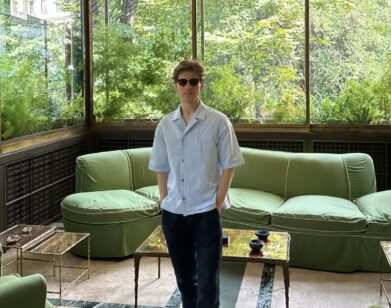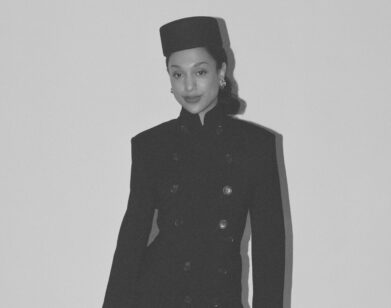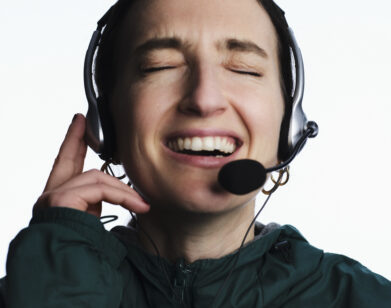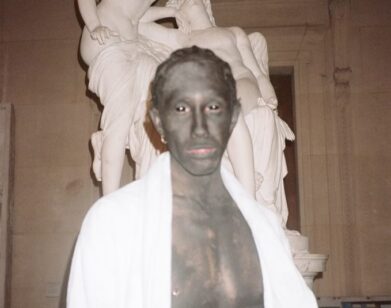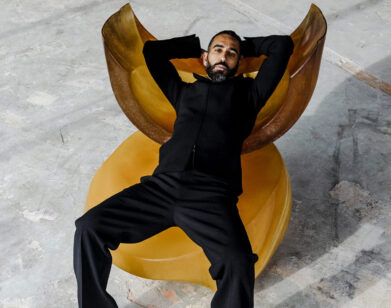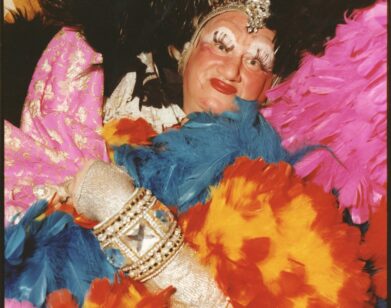Lena Dunham, Just One of the Gang
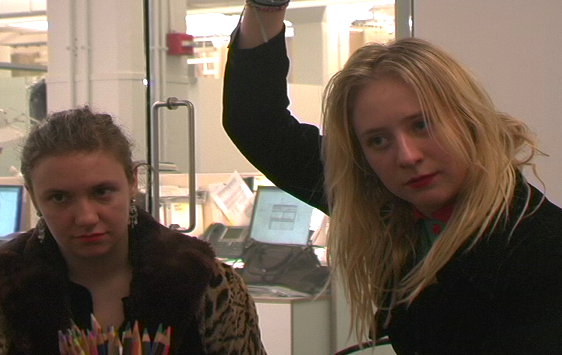

When I met Lena Dunham for lunch in December, she was convalescing from shooting that had run late through the night until early that morning. The 22-year-old New York-based filmmaker is making a series for the web with friends Isabel Halley and Joana D’Avillez, shot and edited by Sara Rossein for Index magazine. Titled Delusional Downtown Divas, it’s a parody of the New York art world’s over-the-top bright young things, and premieres Friday at Art Production Fund Lab, a new art space in Soho run by Yvonne Force Villareal and Doreen Remen. It’s ripe material for the recent graduate, who was raised in the same zoo she mocks—her mother (and sometime collaborator) is the photographer Laurie Simmons; her father, the painter Carroll Dunham.
Dunham’s first feature film, Creative Nonfiction, a pitch-perfect little picture that she wrote, directed, and starred in as an undergraduate at Oberlin, will screen February 18 as part of the NewFilmmakers series at Anthology Film Archives. The plot itself is archetypal: girl likes boy; boy sleeps with girl’s friend; said friend is cattily excommunicated of friendship. But it’s the ever-so-slight level of hysteria in the film’s tone, and a surreal subplot involving a creative writing assignment, that makes Creative Nonfiction a deftly bewitching expression of what it’s like to be a liberal arts undergrad these days. It’s another parody of sorts, but it gets us ever more up close and personal with the budding auteur.
Fan Zhong: Creative Nonfiction is your first feature. You know how writers say they spend their entire lives writing their first novel? I feel like you got a lot of yourself in this movie.
Lena Dunham: Sometimes too much. I was talking to Ray Carney, the film critic. He asked me, ‘Did everyone like it?’ I said, ‘No, I don’t think everyone did.’ And he said, ‘That must be hard when people don’t like it, because there’s a lot of you in that movie.’
FZ: And most of the movie’s set on the Oberlin College campus, in Ohio, which is where you went to school.
LD: I got to Oberlin and I was like, ‘What the hell?’ It’s tiny, about 1,500 students. I got into a creative writing class, and it was pure hell. I started a relationship with a guy in my dorm, and that was pure hell. It all sort of made me say, ‘God! This college thing is such a joke!’ So when Oberlin gave us a month to pursue any project we wanted, I decided to write a screenplay about it. Once I wrote it, it was like, ‘Why would you not make it?’
FZ: Did you get your classmates and friends involved?
LD: We threw a massive party for the party scene. The creative writing class in the movie is my real creative writing class. I had friends holding the boom mic in between their classes. It was all very lo-fi.
FZ: It’s a good time for lo-fi.
LD: A recession-era movie, definitely.
FZ: Did you have any filmmaking experience before this?
LD: I hadn’t. In between writing the script and making it I made two short films to get a sense of how it all works. One of them went to the Slamdance Film Festival in Park City, Utah. Which was fun because it happens at the same time as Sundance; it opened some doors for me. I met these guys in the Red Bucket Film Collective. They made this great film, The Pleasure of Being Robbed. Josh [Safdie] and Sam [Lisenco] were instrumental in helping me make my movie.
FZ: Sam’s in your movie. So is Eleonore Hendricks [from The Pleasure of Being Robbed].
LD: Eleonore was so amazing in their movie. I wish she’d been in my movie more.
FZ: Who did you find to play the other parts?
LD: Just friends. For the speaking parts, no one was an actor. I was amazed by the performances that came out.
FZ: What’s great was that everyone was so game to make fun of themselves.
LD: I learned that people are much more game to mock their own personas than you would think. In the new web show I’m doing for Indexmagazine.com and APF Lab, there are so many art-world people we’ve gotten to play some weird, absurd version of themselves.
FZ: I hear Nate Lowman’s in it.
LD: Nate was totally down to make fun of himself as this glamorous, bad-boy artist. Isaac Mizrahi’s in it. We have this guest-starring role for Clarissa Dalrymple, who’s this fabulously decadent personality. We shot stuff at the Beatrice; we got both of the doormen to play awesomely pissed-off doormen. And Rachel Chandler deejays in it.
FZ: So the basic idea of this web series is …
LD: It’s about three girls who grew up vaguely around the New York art world. [laughs] I know, not autobiographical at all. These girls are trying to enter what they think of as the hip downtown art scene. And they have no idea how to go about it.
FZ: So they just want to be art-world hangers-on.
LD: Absolutely. They each claim to have a career. One claims to be a “private performance artist.” One is a novelist. The third is a “businesswoman,” though it never becomes clear what her business consists of. And we’re getting an Yvonne [Force Villareal] cameo. Just because there’s no way we can have Yvonne not walk in wearing one of her unbelievable outfits.
FZ: How did you hook up with Yvonne and APF Lab?
LD: Yvonne’s always been supportive of my mom’s work. When I had a screening of Creative Nonfiction at Anthology Film Archives back in September, the artist Hanna Liden gave Yvonne and Doreen [Remen] a positive review of my film. Which was very exciting. They came to me and said they had this new space, and they were looking to screen video there.
FZ: And your mom produced the movie.
LD: She did. Which, as I tell people, secretly means that she just bought a lot of pizza. [laughs]
FZ: Did she have any creative input?
LD: Yes, but she was very respectful. I know she’s very opinionated, she and I have been writing this script together for something we want to shoot next year. It’s a musical called Counting by Eighths. It’s about a lounge singer with—I’m going to give it away here—obsessive-compulsive disorder. We got to the second round of the Sundance Screenwriters Lab. We’re waiting to hear if we got in.
FZ: What’s the Screenwriters Lab?
LD: It’s this thing where they’ll ship screenwriters off to whichever crazy Robert Redford ranch for a week to work on your script.
FZ: He kind of scares me, Robert Redford.
LD: I know! A little … wooden.
FZ: Has your dad seen the sex scene?
LD: He hasn’t. I think he’s a little nervous about the movie. He’s never watched it all the way through.
FZ: And there was nudity in that scene.
LD: Was there ever! It seems to be my lot in life to show my boobs. Here it was on purpose, because that needed to happen for my character, but I made a web show for Nerve.com where I showed my boobs accidentally, and for Delusional Downtown Divas we shot one scene that we thought was above the shoulders.
FZ: How was shooting the sex scene?
LD: Nerve-wracking. When it’s low-budget, and you have one other person on the set, you have to make rules. In Hollywood, you’ve got a hundred people on set, and you’re wearing nude-toned underwear and tape on your nipples. Nothing is going beyond where you want it to go. Here, we were naked. Yvonne saw it and actually thought we were having sex. We were not having sex.
FZ: That’ll be on all the press releases.
LD: Exactly: ‘Come see real sex!‘ The girl I share an office with, Greta Gerwig, she directed this film with Joe Swanberg called Nights and Weekends. In that movie there was no actual sex, but there was an unsimulated boner.
FZ: An unsimulated boner? I’m scared to ask, but … how does one simulate a boner?
LD: You can’t! Well, I guess you could have something in your—
FZ: Ouch.
LD: That was a huge deal to people, the flat-out erection. I was fine watching it, but as a filmmaker it would’ve crossed the line for me.
FZ: So you were comfortable with the way your sex scene unfolded.
LD: Totally. We only did two takes. Sex is just so embarrassing, watching it reminds me of how embarrassing it is. When you’re in it, you’re like, ‘Oh, I guess this isn’t so bad.’ But …


